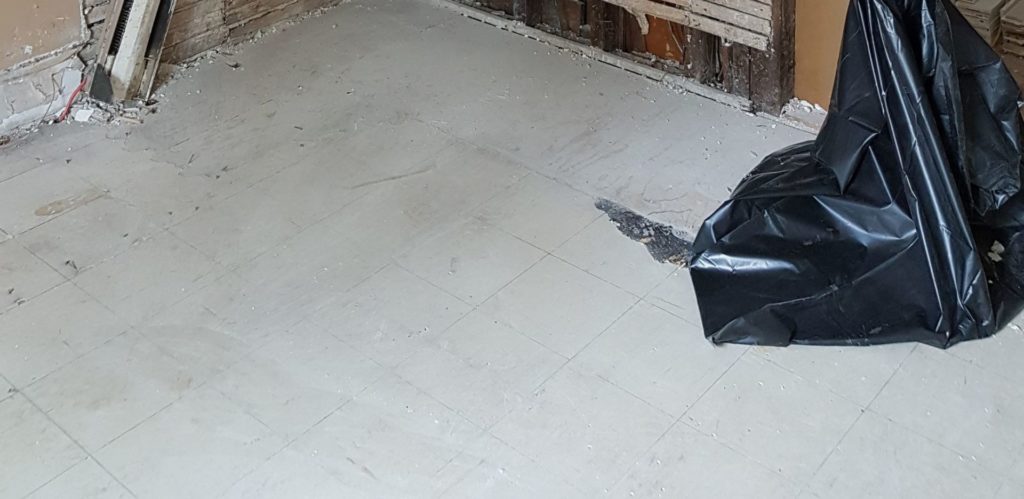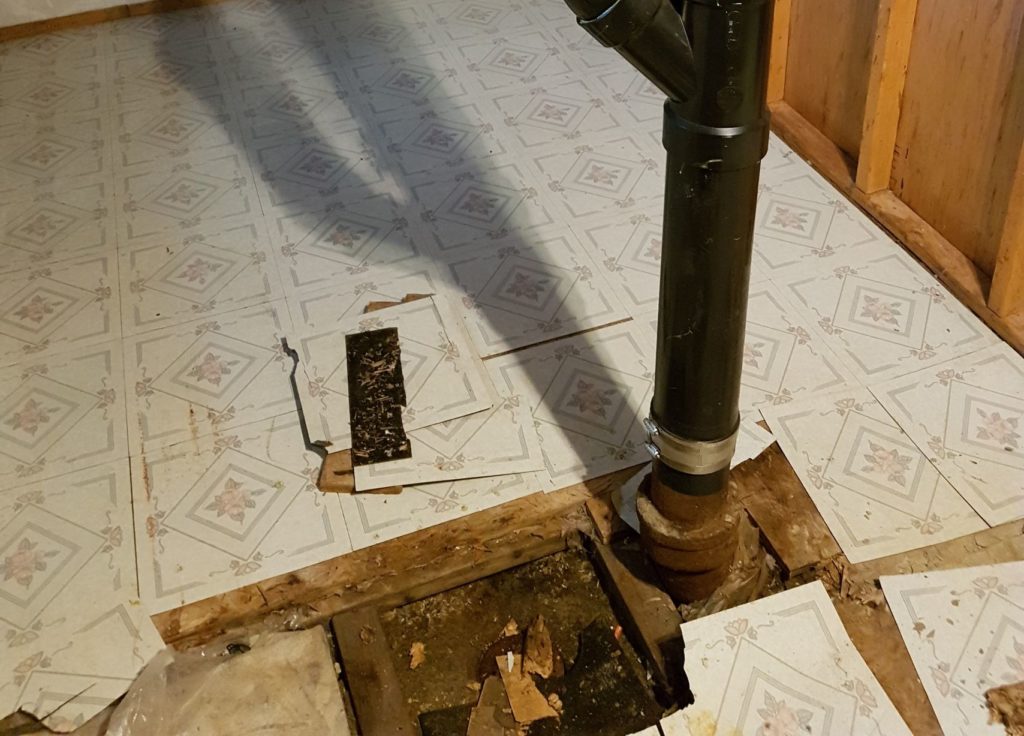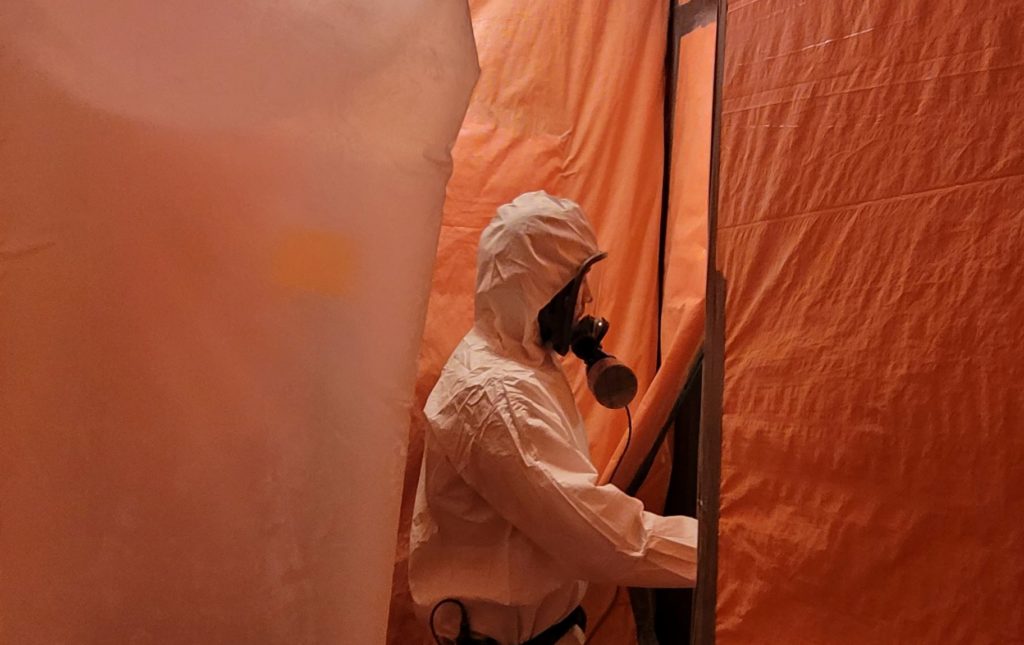Asbestos Floor Tiles
Table of content
- Everything you need to know about asbestos floor tiles
- Asbestos in floor tiles, 6 Ways to recognize them
- Is it dangerous to live in a house with asbestos floor tiles ?
- Is there asbestos in the glue and black putty ?
- When was asbestos banned in Canada for vinyl tiles ?
- What are the health issues caused by asbestos ?
- Asbestos flooring tiles removal
- Free quote
Asbestos in Tiles : Discover whether your flooring contains this prohibited substance and, if it does, learn how to address it—whether your intention is to eliminate it, conceal it, or leave it undisturbed.
Everything you need to know about Asbestos floor tiles
Asbestos tiles were commonly used in construction from the 1920s through the 1980s due to their durability and fire resistance. They were typically 9 inches by 9 inches with a marbled or flecked appearance. However, asbestos poses serious health risks when its fibers become airborne and are inhaled.
Exposure to asbestos is associated with severe health issues, including asbestosis, lung cancer, and mesothelioma. As a result, the removal and handling of asbestos-containing materials, including floor tiles, are heavily regulated. Professional testing and removal services are recommended due to the potential health hazards involved.

In some cases, encapsulation or encasement may be employed as temporary solutions to prevent the release of asbestos fibers. Encapsulation involves sealing the tiles, while encasement involves covering them with a protective barrier.
DIY removal is strongly discouraged, and homeowners should consult with certified professionals for any asbestos-related concerns. Legal responsibilities regarding asbestos vary, and non-compliance can lead to fines and penalties.
Modern flooring materials such as vinyl, linoleum, ceramic tiles, and hardwood are asbestos-free alternatives. If you suspect asbestos in your home, it is crucial to treat the material as if it contains asbestos until proven otherwise. Minimize disturbance, avoid activities that may release fibers, and consult professionals for testing and removal.
Asbestos waste must be disposed of in accordance with local regulations, typically involving sealing it in leak-tight containers and delivering it to an approved disposal site. Safety precautions should always be followed, and professional consultation is essential to ensure the well-being of individuals in the environment.
These asbestos tiles were often attached to a thin adhesive paper which also contained asbestos. If the asbestos tile is partially or completely broken into pieces, this asbestos-containing glaze can be spread throughout the house and inhaled by people inside. For example, opening a closet door on asbestos tiles can release asbestos fibers into the air. Asbestos tiles probably have an asbestos-cement or asbestos-paper backing. Asbestos was often mixed with plaster to make asbestos-cement products such as liners, pipe insulation, and switch plates. The word “asbestos” was not used, but these products had the following abbreviation: MCA.
A paper product containing asbestos was asbestos building board, which was used to build interior walls and around door and window frames. The asbestos in this product has been linked to mesothelioma, a cancer of the lining of the chest or abdominal cavity. Other products containing asbestos, such as asbestos pipes and asbestos insulation, have been used to build houses. Asbestos materials in your home may contain asbestos if they are older than 1980. However, many products containing asbestos have been retired or simply covered with newer materials. Asbestos tiles may not be present in your home at all.
A specialist inspector can come to your home to test samples of asbestos tiles. If there is asbestos, you can have the asbestos tiles replaced with new tiles.
Sometimes asbestos tiles can be repaired with the right adhesive and patching material, but that’s not always possible. Before attempting to repair asbestos tile, it is best to consult a professional asbestos removal contractor who will be able to assess the condition of the asbestos tile and recommend specific actions.
Homeowners with vinyl asbestos tiles should consider taking precautionary measures when they notice signs of deterioration of the asbestos tiles. Areas subject to heavy wear are areas of concern. Damaged asbestos roof tiles present the greatest risk of asbestos exposure. For asbestos tiles to be safe to use, they must be properly repaired or covered with a coating that prevents asbestos fibers from escaping into the air.
Unlike other friable materials that contain asbestos, vinyl tiles are safe, provided it shows no signs of deterioration. To avoid breathing its particles, it is important not to remove the asbestos tiles yourself. The best way to find out if your floor contains asbestos is to send a sample to a laboratory for a materials test.
Asbestos tiles how to tell ?
Vinyl tiles, found in a variety of colors and patterns: Beginning in the 1920s, vinyl and asbestos were frequently combined due to their strength and low cost. Tiles containing asbestos were often 6″x6″, 9″x9″ or 12″x12″. Asbestos was often added to vinyl before the tile was made. After the asbestos is mixed with the liquid vinyl, it is poured onto a flat surface and rolled to create thin sheets of asbestos-containing tile.The asbestos content of these types of flooring was generally between 30 and 50%. Asbestos-containing tiles were produced until the late 1970s in many cases.
Asbestos in Floor tiles 6 ways to recognize them
Recognizing vinyl tiles containing asbestos can be tricky because asbestos is not visible to the naked eye. However, here are some indications that could help you identify vinyl tiles that may contain asbestos:
- Installation date prior to the 1980s: Products containing asbestos were commonly used before the 1980s. If your home or building was constructed or renovated before this time, there is an increased likelihood that materials, including vinyl tiles, may contain asbestos. asbestos.
- Search for brands or manufacturers known to have used asbestos: Some manufacturers have been linked to the use of asbestos in their products. Look for information on the manufacturer of the vinyl tiles, and if there is any doubt about the use of asbestos, have appropriate testing carried out.
- Visual aspect : Vinyl tiles containing asbestos may have a visible fibrous texture on the surface. They can also have a specific shade, often in shades of beige, brown or gray. However, appearance alone is not enough to confirm the presence of asbestos.
- Thickness and flexibility: Vinyl tiles containing asbestos may be thicker and less flexible than non-asbestos tiles. However, this method is quite subjective and does not provide reliable confirmation.
- Professional laboratory tests: The only sure way to confirm the presence of asbestos is to have laboratory testing performed by qualified professionals. Samples can be taken and analyzed for the presence of asbestos.
- Certificates or installation documentation: Consult any documentation related to flooring installation. In some cases, there may be records or certificates indicating whether asbestos-containing materials were used.
Remember that handling possible asbestos-containing materials should be done with caution, or avoided if possible, due to the health risks associated with inhaling asbestos fibers. If in doubt, always consult a qualified professional for appropriate testing and advice.
Is it dangerous to live in a house with asbestos vinyl floor tiles ?
Living in a house with asbestos vinyl floor tiles can pose potential health risks if the asbestos fibers are released into the air. Asbestos is hazardous when its microscopic fibers become airborne and are inhaled. Prolonged exposure to these fibers is associated with serious health conditions such as asbestosis, lung cancer, and mesothelioma.
If the vinyl floor tiles are in good condition and undisturbed, the risk of exposure is lower. However, if the tiles are damaged, deteriorating, or if there are renovations or activities that disturb the tiles, it can release asbestos fibers into the air.
To ensure safety:

Professional Assessment: Have the tiles assessed by asbestos professionals to determine their condition.
Prevent Disturbance: Avoid activities that may damage the tiles or release fibers, such as drilling or sanding.
Professional Removal: If removal is necessary, hire certified professionals to safely handle and dispose of the asbestos-containing materials.
Regular Monitoring: Regularly monitor the condition of the tiles and address any issues promptly.
If you suspect the presence of asbestos or have concerns about the condition of the vinyl floor tiles, consult with asbestos experts for proper assessment and guidance to mitigate potential health risks.
Is there asbestos in glue and black putty?
Asbestos was commonly used in various construction materials, including adhesives and putties, due to its fire-resistant and insulating properties. In the context of vinyl floor tiles, asbestos-containing materials might be found not only in the tiles themselves but also in the adhesives or mastics used to install them. The black adhesive or putty used to secure vinyl floor tiles may contain asbestos, especially if it was installed before the 1980s when asbestos use in construction materials was more common. Asbestos was often added to these materials for its strength and fire-resistant qualities.
To determine if there is asbestos in the adhesive or putty, it’s recommended to have a professional asbestos inspection. Certified asbestos inspectors can take samples and send them to a laboratory for analysis. Handling or disturbing materials that may contain asbestos, such as removing tiles or scraping adhesives, can release asbestos fibers into the air, presenting serious health risks. Therefore, if there is a suspicion of asbestos, it’s crucial to consult with asbestos professionals for proper testing and safe removal procedures.
This adhesive was mixed with asbestos fibers because it had much better insulation values than standard adhesives. It is therefore easily recognizable due to its black color. It was also more fire resistant. This is why we often see asbestos glue in combination with wooden floors. But also for stone or concrete floors, asbestos glue was used for fixing.
When was asbestos banned in Canda for vinyl tiles?
Asbestos has been used in a variety of products, including asbestos floor tiles. In its raw form, asbestos is a naturally occurring mineral that has been mined and was once commonly used due to its fire resistance and durability.
In Canada, asbestos was phased out of floor tiles in the early 1980s and is no longer used today in any product that would be installed or handled during renovations or repairs. The asbestos tiles in your home likely contained asbestos until the mid-1980s, when the EPA banned its use in tiles in the United States. In Canada, asbestos tiles were banned in 1985.
Prior to this date, vinyl asbestos tiles containing asbestos could be available for sale. After December 31, 1990, vinyl asbestos floor tiles containing asbestos were no longer manufactured or imported into Canada and could no longer be legally sold or installed. Vinyl asbestos floor tiles manufactured before 1990 may still be found in some Canadian homes and commercial buildings.
If asbestos is detected in the tiles, asbestos removal must take place. Asbestos materials must be transported to a landfill designated by a contractor or asbestos removal company.
An asbestos tile test is the only way to determine if your vinyl flooring contains asbestos fibers. The test can identify where vinyl flooring that contains asbestos is and provide information on asbestos levels. In conclusion, if you suspect the presence of asbestos in your vinyl tiles, contact us and we will be able to assist you with your asbestos removal work.
What are the health issues caused by asbestos ?
Exposure to asbestos can lead to serious health issues, primarily affecting the respiratory system. The health problems associated with asbestos exposure include:
Asbestosis: A chronic lung disease caused by the inhalation of asbestos fibers. Results in the scarring of lung tissue, leading to breathing difficulties.
Lung Cancer: Asbestos exposure increases the risk of developing lung cancer. Smokers with asbestos exposure face a significantly higher risk.
Mesothelioma: A rare and aggressive cancer that occurs in the lining of the lungs, abdomen, or heart. Almost exclusively linked to asbestos exposure.
Pleural Diseases: Conditions affecting the lining around the lungs (pleura). Can include pleuritis and pleural plaques.
Gastrointestinal Cancers: Some studies suggest a potential link between asbestos exposure and cancers of the esophagus, stomach, and colon.
Asbestos-Related Lung Effusions: The accumulation of fluid between the layers of the pleura, often associated with asbestos exposure.
It’s important to note that the health risks of asbestos are directly related to the extent and duration of exposure. Asbestos-related diseases often have a long latency period, and symptoms may not appear until many years after exposure. Preventive measures, such as avoiding asbestos exposure and following proper safety procedures during asbestos removal or renovation activities, are crucial to minimizing health risks. If there is a suspicion of asbestos in a building, it is recommended to consult with asbestos professionals for testing and, if necessary, safe removal.
Asbestos flooring tile removal
When hiring a company for asbestos removal, it’s crucial to choose a licensed and certified asbestos abatement professional. These professionals have the training and expertise to handle asbestos safely and in compliance with local regulations. Additionally, they can conduct proper testing and ensure the safe disposal of asbestos-containing materials.
At Gestion Xpress Demolition, we know that the discovery of asbestos in materials is worrying, but be aware that the dangers are moderate if they are not friable and if you do not handle them. In addition, it is possible to remove the materials safely while limiting inconvenience. If you suspect the presence of asbestos in your property, avoid any manipulation and contact us now, we will be able to guide you in making informed decisions.
As a contractor specializing in asbestos removal, we offer a turnkey service for complete and safe management of your asbestos decontamination work.

